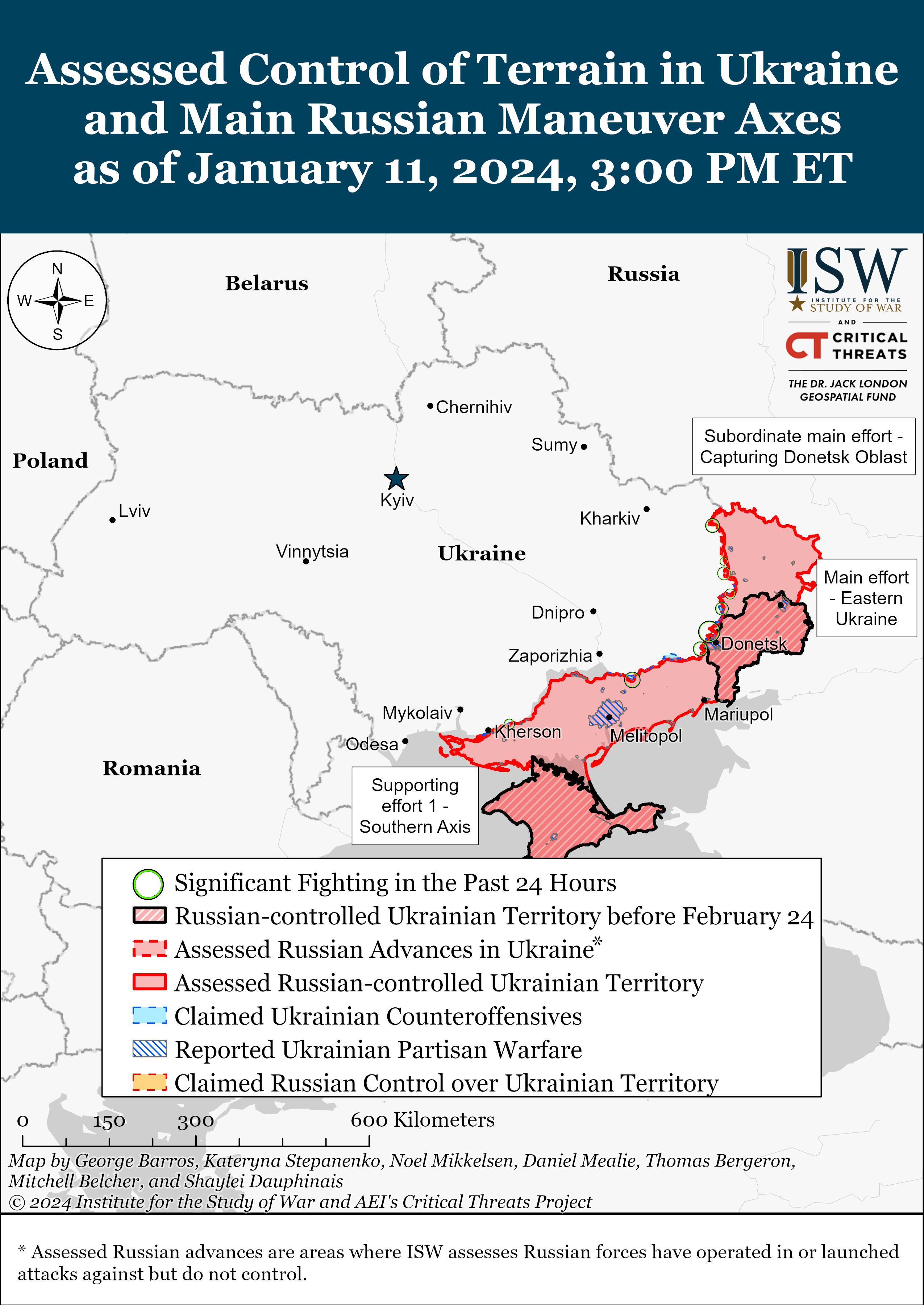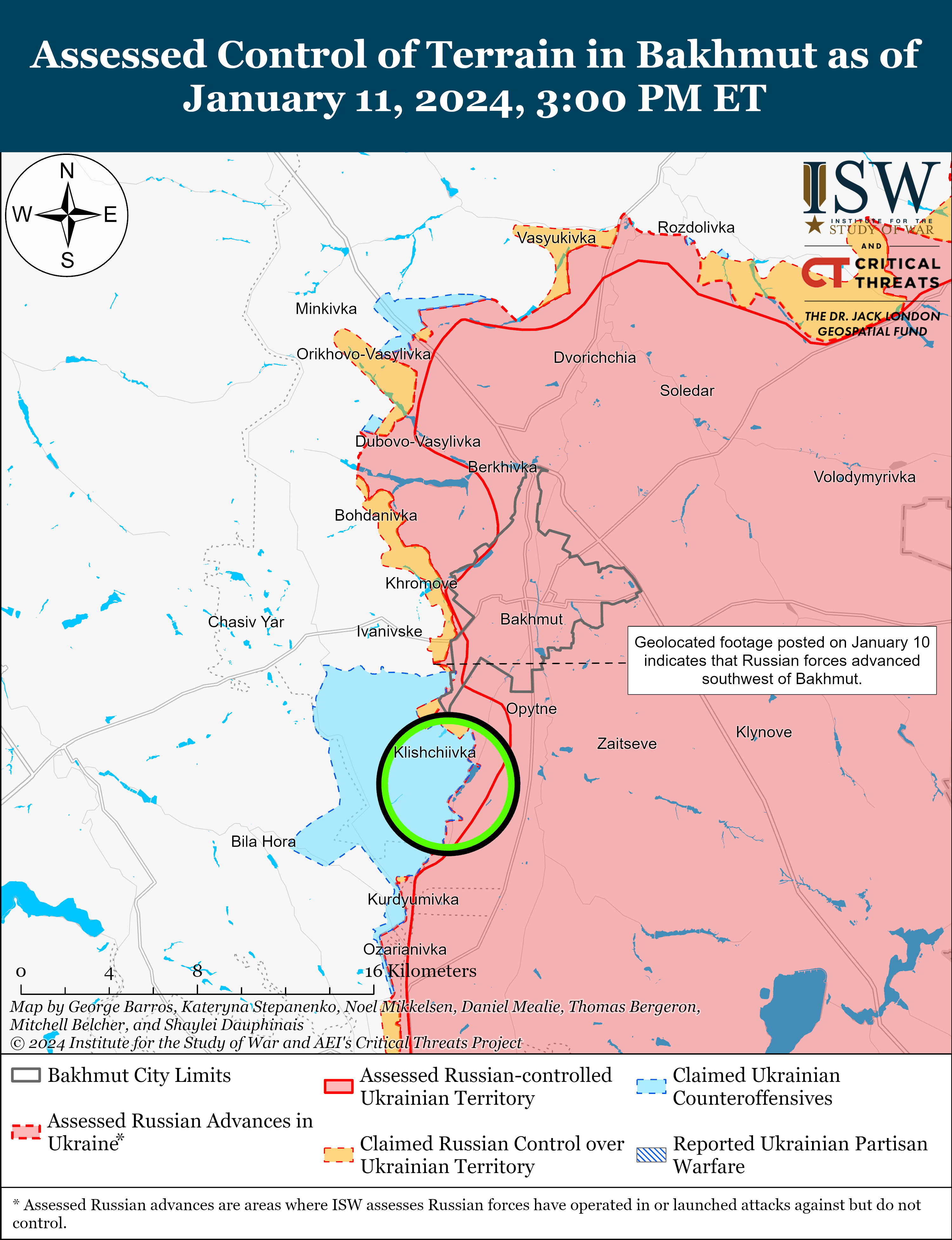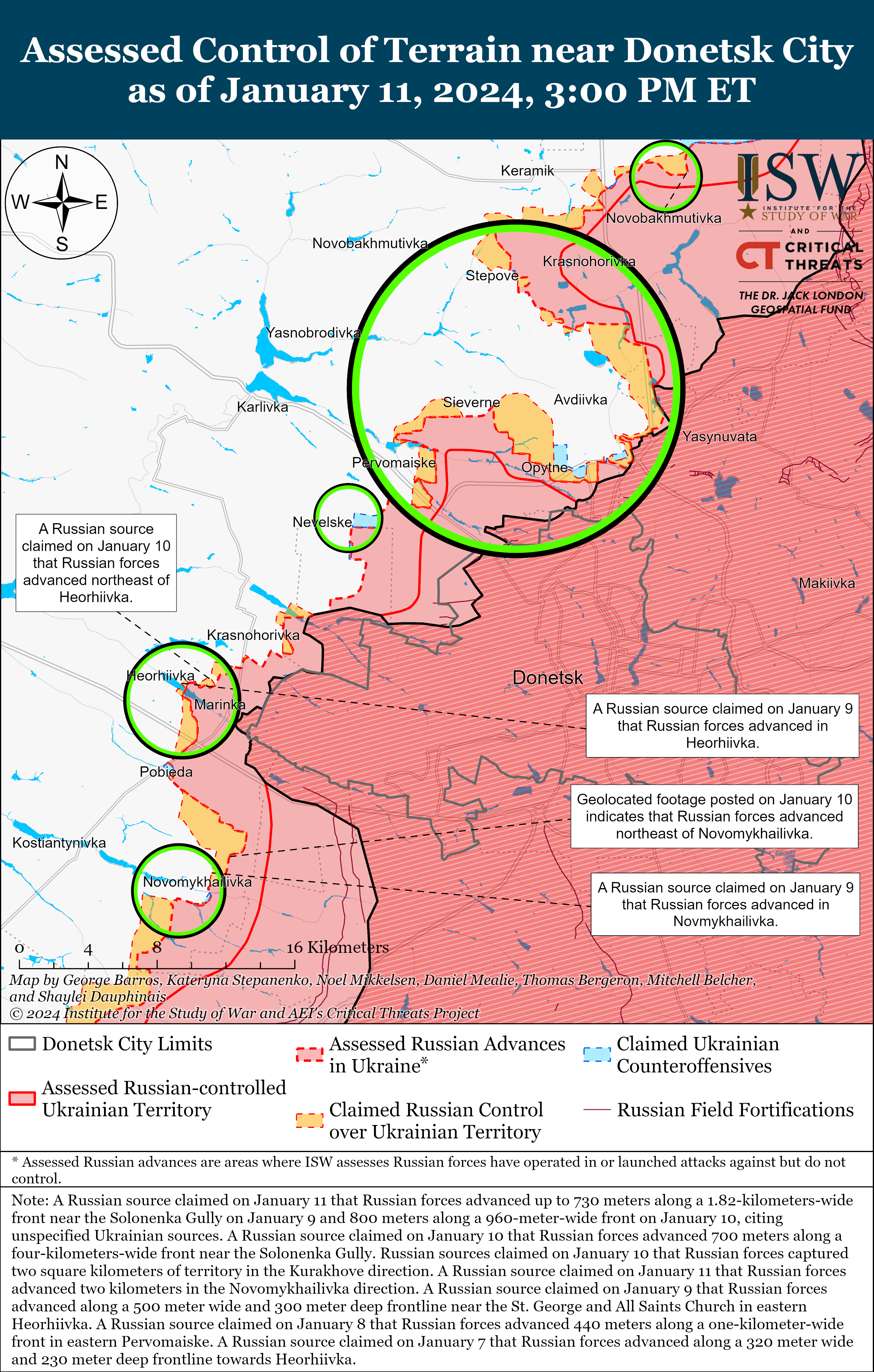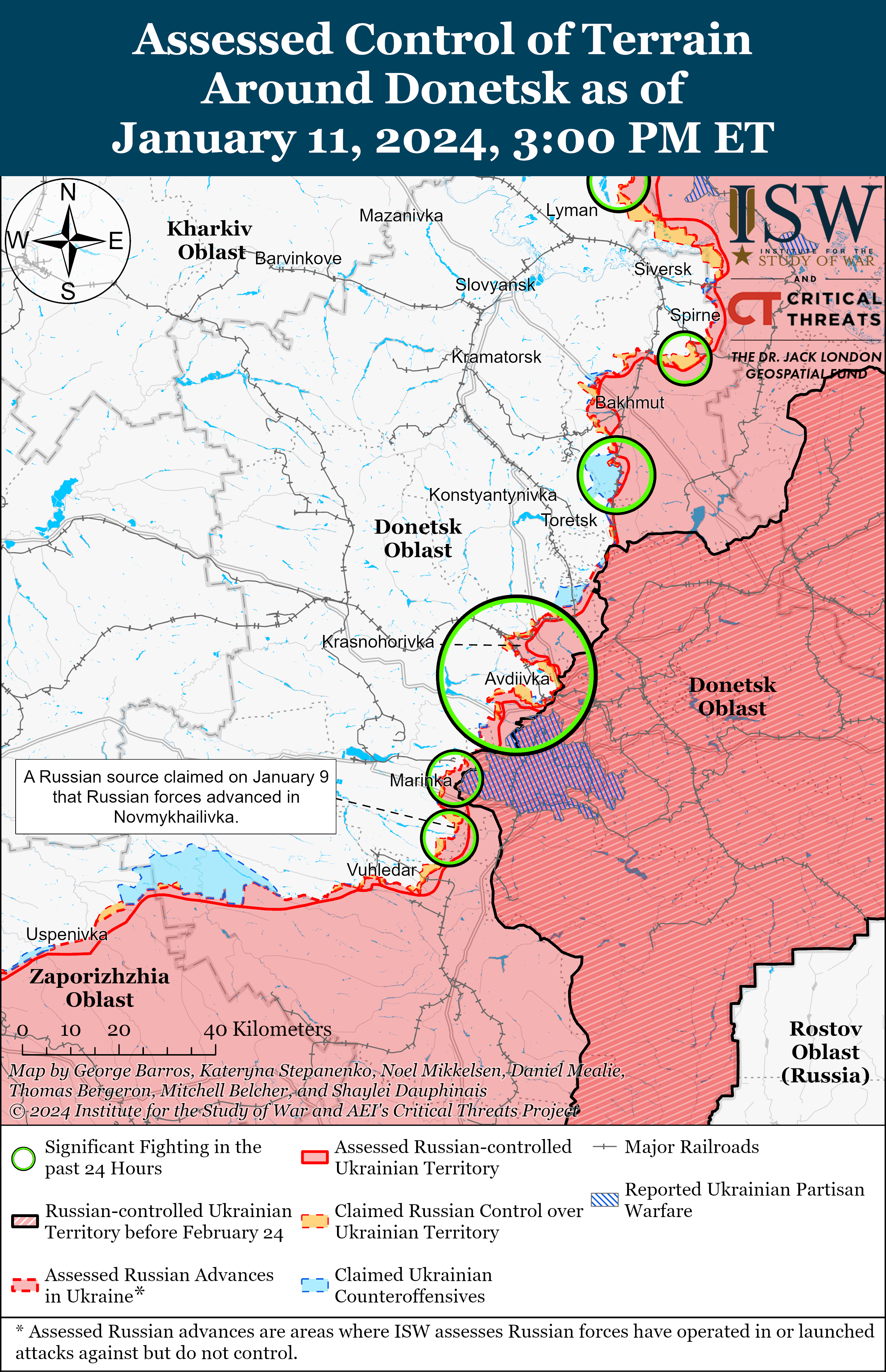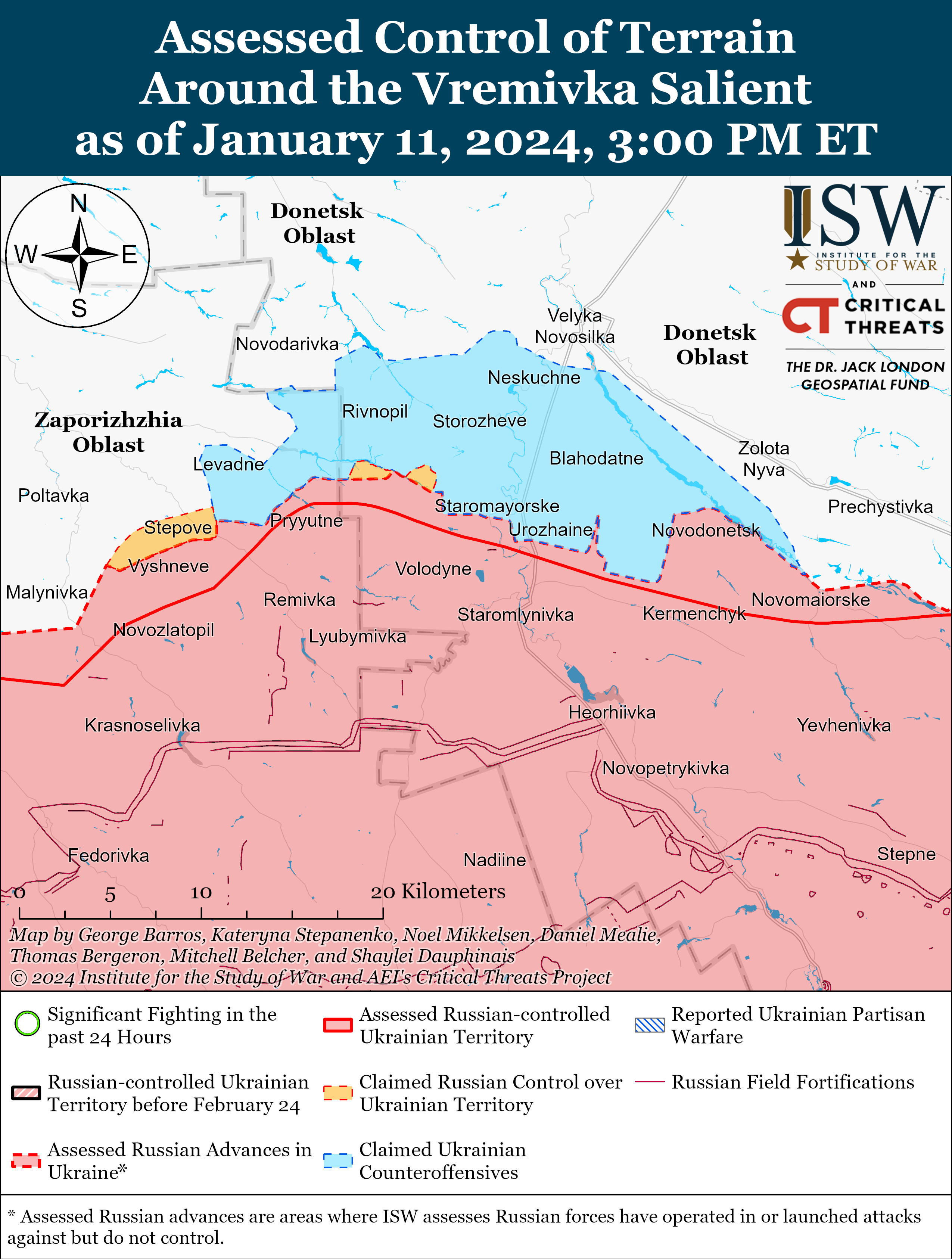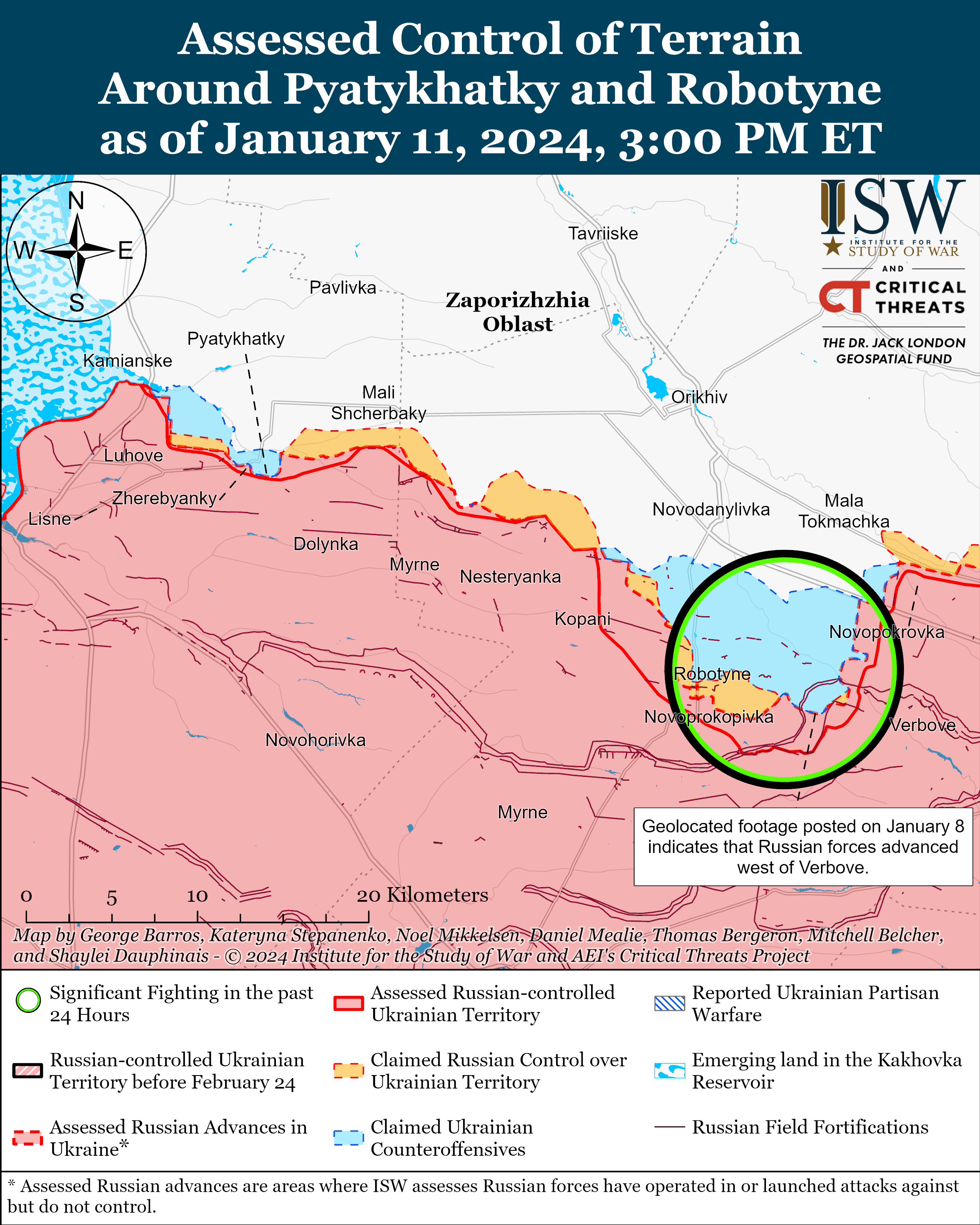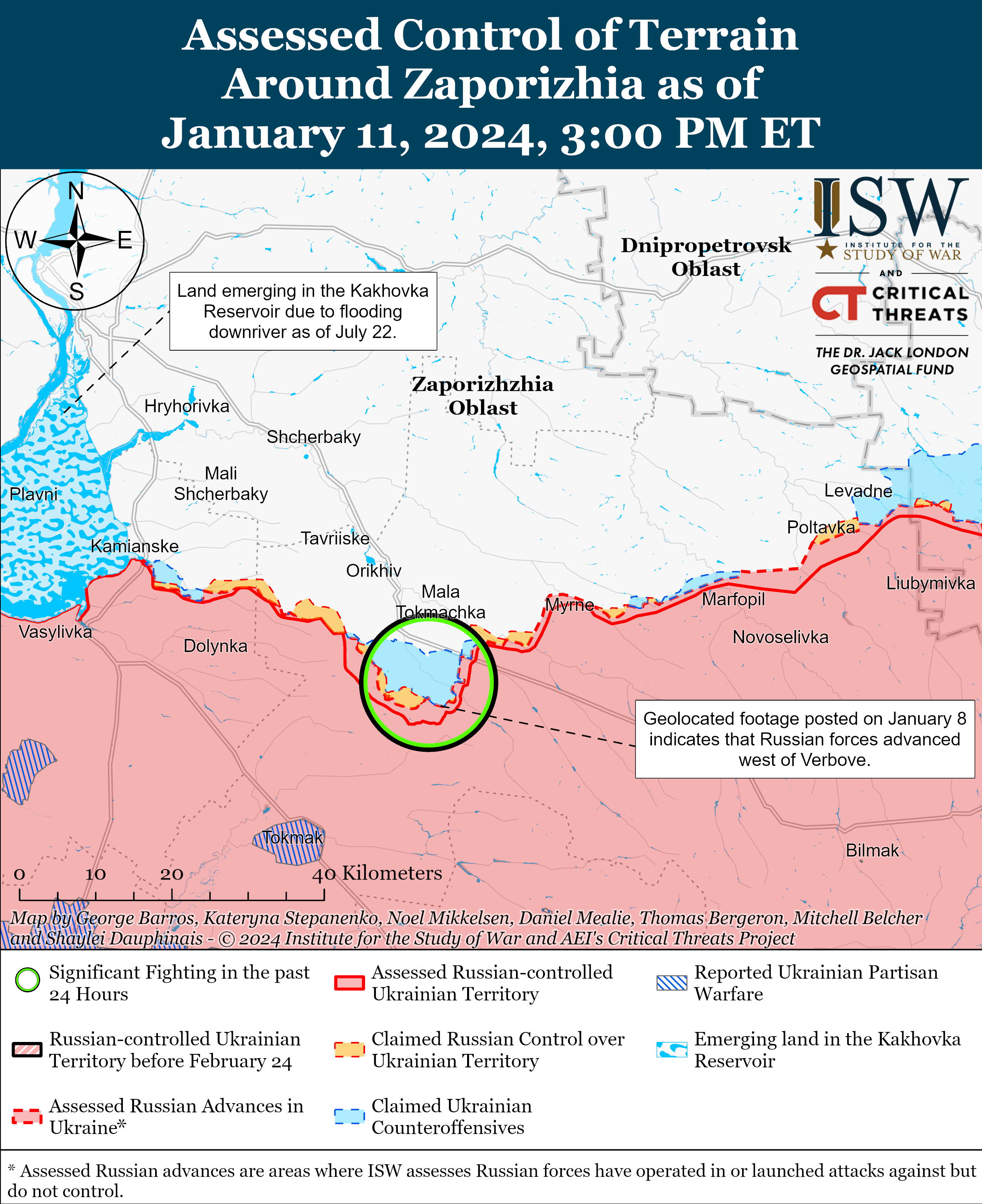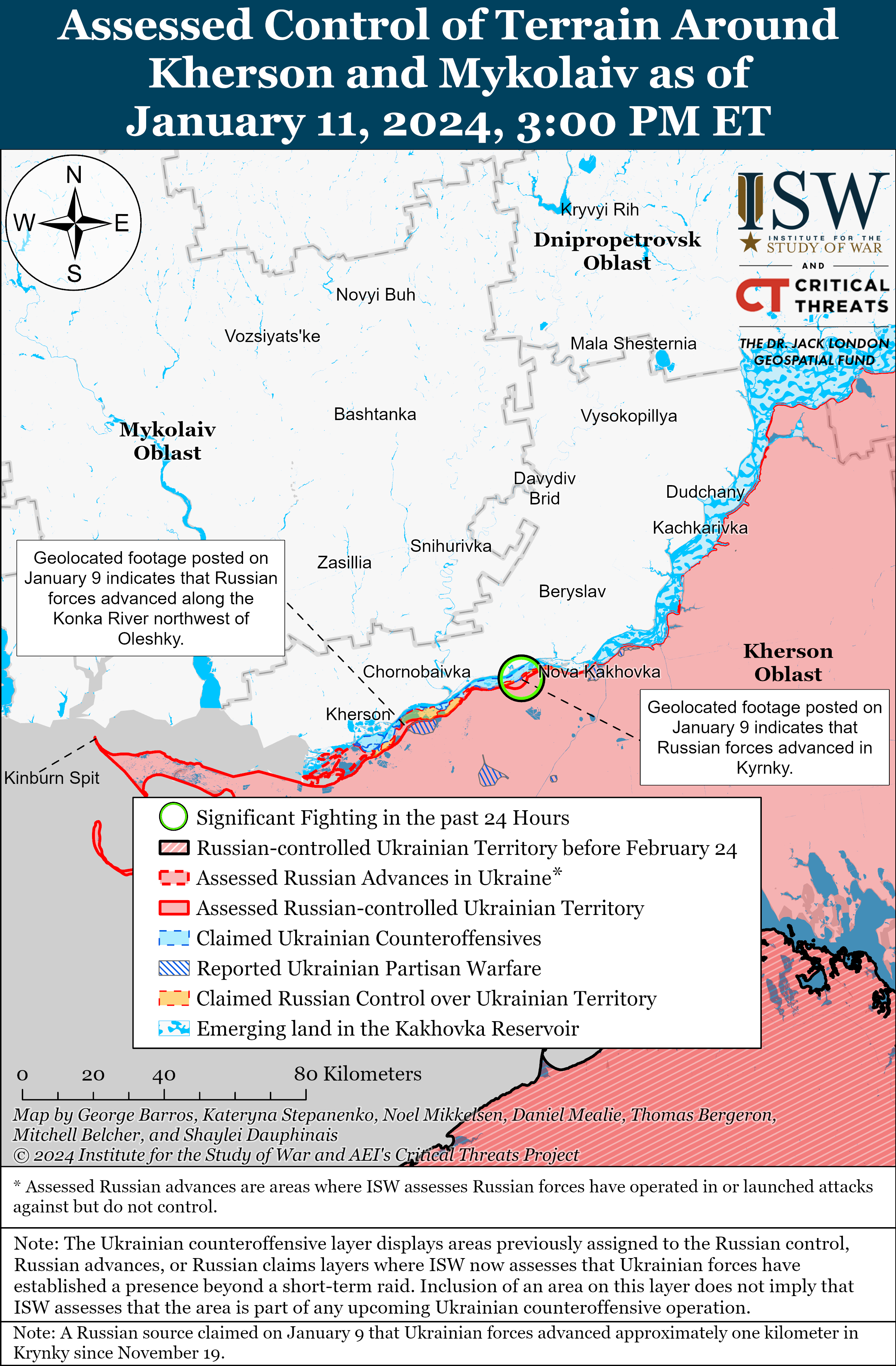Riley Bailey, Angelica Evans, Nicole Wolkov, Grace Mappes, and Frederick W. Kagan
January 11, 2024, 7:25pm ET
Click here to see ISW’s interactive map of the Russian invasion of Ukraine. This map is updated daily alongside the static maps present in this report.
Click here to see ISW’s 3D control of terrain topographic map of Ukraine. Use of a computer (not a mobile device) is strongly recommended for using this data-heavy tool.
Click here to access ISW’s archive of interactive time-lapse maps of the Russian invasion of Ukraine. These maps complement the static control-of-terrain map that ISW produces daily by showing a dynamic frontline. ISW will update this time-lapse map archive monthly.
Note: The data cut-off for this product was 1pm ET on January 11. ISW will cover subsequent reports in the January 12 Russian Offensive Campaign Assessment.
The reported concentration of the Russian military’s entire combat-capable ground force in Ukraine and ongoing Russian force generation efforts appear to allow Russian forces to conduct routine operational level rotations in Ukraine. Ukrainian Main Military Intelligence Directorate (GUR) Deputy Chief Major General Vadym Skibitskyi stated on January 11 that Russian forces have 462,000 personnel in Ukraine and that this represents the entire land component of the Russian military.[1] Skibitskyi stated that most Russian units in Ukraine are manned at between 92 and 95 percent of their intended end strength and that the size of the Russian grouping in Ukraine allows Russian forces to conduct rotations throughout the theater.[2] Skibitskyi stated that Russian forces withdraw units that are at 50 percent or less of their intended end strength to rear areas and return them to the front following recovery and replenishment.[3] Russian Security Council Deputy Chairperson Dmitry Medvedev stated on January 11 that the Russian military has successfully replenished Russian forces in Ukraine through an ongoing crypto-mobilization effort that generated over 500,000 new personnel in 2023.[4]
ISW previously observed routine Russian struggles to conduct operational level rotations from the start of Russia’s full-scale invasion in February 2022 through Ukraine’s summer 2023 counteroffensive.[5] The apparent Russian ability to generate forces at a rate equal to Russian losses likely provides Russian forces the ability to replenish units that the Russian command has withdrawn from the line due to degradation and later return these replenished units to the front.[6] Russian forces maintain the initiative throughout eastern Ukraine, and the absence of Ukrainian counteroffensive operations likely removes pressure on operational deployments that had previously partially restrained the Russians‘ ability to conduct rotations.[7] Russian forces have not seized the battlefield initiative in Kherson Oblast, however, and appear to be degrading units and formations operating near the Ukrainian bridgehead on the east (left) bank of the Dnipro River without making apparent efforts to conduct operational level rotations (although they do appear to conduct tactical-level rotations).[8] Russian forces have conducted several regroupings during localized offensive operations in the Avdiivka, Bakhmut, Lyman, and Kupyansk directions since early October 2023, which likely provided Russian forces time to conduct the rotations Skibitskyi described.[9] ISW has not observed widespread Russian complaints about a lack of rotations throughout the theater since summer 2023, and the overall tempo of Russian operations is consistent with Skibitskyi’s reporting.[10]
Russia’s ability to conduct operational level rotations will likely allow Russian forces to maintain the overall tempo of their localized offensive operations in eastern Ukraine in the near term, but it is unclear if Russian forces will be able to conduct effective rotations in the long term or in the event of intensified Russian offensive efforts or a significant Ukrainian counteroffensive operation. Russian operational rotations in principle mitigate the degradation of attacking Russian forces that over time could cause Russian offensive efforts to culminate. Several other operational factors have previously contributed to the culmination of Russian offensive efforts in Ukraine, but constraints on available manpower and combat effective formations have often been a primary factor.[11] Russian forces are largely conducting infantry-heavy assaults in Ukraine with assault groups that do not necessarily require large amounts of equipment or high levels of training.[12] The Russian force generation apparatus appears to be replenishing losses in Ukraine with poorly trained and relatively combat ineffective personnel whom the Russian command has deemed to be sufficient for routine attritional frontal assaults.[13] These assaults have yet to result in more than marginal Russian gains in Ukraine since early October 2023, and it is unlikely that Russian forces can continue them indefinitely in a way that will allow the Russians to convert tactical successes into operationally significant results. Successful Russian operational-level offensives in Ukraine will require the Russian command to commit relatively combat effective and well-equipped units and formations to offensive operations at scale, and it is unclear if replenishment through these Russian operational rotations will suffice to maintain these units’ combat capabilities. Overall Russian combat capabilities in Ukraine may still degrade over time, therefore, despite the rotations, hindering the Russian military’s ability to sustain several significant offensive operations at once.
The Russian military may also incur losses greater than Russia’s ability to generate new forces if the Russian command decides to intensify offensive efforts in Ukraine, thereby limiting the manpower available to replenish degraded units and formations. The intensification of Russian offensive efforts would commit more elements to the frontline and place pressure on the number of available forces that could assume control over a degraded unit’s area of responsibility while that unit underwent rest and restoration. It is unclear if the current Russian crypto-mobilization campaign, which relies heavily on volunteer recruitment and the coercive mobilization of convicts and migrants, would be able to provide the increased number of personnel required to conduct rotations during an intensified Russian offensive effort.[14]
Ukrainian intelligence reported that Russian efforts to expand Russia’s defense industrial base (DIB) have yet to fulfill operational requirements in Ukraine and that munitions shortages will continue to prompt Russia to source supplies from abroad. Ukrainian Main Military Intelligence Directorate (GUR) Deputy Chief Major General Vadym Skibitskyi stated that the Russian defense industrial base (DIB) can produce two million rounds of 122mm and 152mm shells annually, which resulted in a deficit of 500,000 shells in 2023 and will likely result in a similar deficit in 2024.[15] Skibitskyi stated that Russia plans to increase its ammunition production in 2024 but lacks the necessary components, qualified personnel, and production capabilities.[16] Skibitskyi noted that Russia has previously purchased shells from Belarus, Iran, and North Korea and assessed that Russia will likely seek to procure additional shells from abroad in 2024 and beyond.[17] Ukrainian President Volodymyr Zelensky warned on January 11 that Russia will use any “pause” or temporary ceasefire agreement to stockpile drones, artillery, and missiles and address its large materiel shortages ahead of future aggression against Ukraine.[18] Zelensky added that Russia is currently negotiating the acquisition of additional missiles and ammunition from other countries and noted that Russia has already received more than one million shells from North Korea.[19] Ukrainian Prosecutor General Andriy Kostin also confirmed recent Western reports that Russian forces have already launched at least one North Korean missile against Ukraine.[20]
Politico, citing a report by the Kyiv School of Economics and Yermak-McFaul International Working Group on Russian Sanctions, reported on January 11 that despite Western sanctions, Russia imported $8.77 billion worth of goods and components necessary to produce missiles, drones, armored vehicles, and other military equipment between January and October 2023.[21] The report states that Russia’s capacity to manufacture missiles and drones appears to have increased in 2023 despite Western sanctions, and Politico stated that Russia increased its production of missiles to 115 per month by the end of 2023.[22] The report noted that sanctions have strained Russia’s supply chains and have caused “unparalleled losses” in Russia’s overall production of military aviation and equipment, however.[23]
Ukrainian and Western sources have previously reported on Russia‘s sanctions evasion schemes to acquire foreign components and noted that Russia’s reliance on foreign components has constrained Russia’s domestic production of aircraft, missiles, and drones.[24] An unnamed Russian drone manufacturer also drew Russian President Vladimir Putin’s attention to the fact that a “large percentage” of electronics, particularly drones, produced in Russia require foreign components during a campaign event in Russia’s Far Eastern Federal District on January 11, prompting Putin to acknowledge the importance of this issue and the need to address Russia’s reliance on foreign components.[25] ISW previously assessed that Russia’s current missile and drone reserves and production rates likely do not allow Russian forces to conduct regular large-scale missile strikes, but likely do allow for more consistent drone strikes due to Russia’s ability to produce drones at a much higher rate (roughly 1,400 Shahed-136/131 drones between February and October 2023).[26] The Russian government is likely attempting to develop domestic substitutions for foreign components to sustain and even increase its domestic drone and missile production despite Western sanctions.
Freezing temperatures in Ukraine are likely constraining operations along the front but will likely create more favorable terrain for mechanized maneuver warfare as the ground freezes in the coming weeks. The deputy commander of a Ukrainian brigade operating in the Kupyansk direction stated that Russian forces are using fewer loitering munitions in the Kupyansk direction due to cold weather.[27] Ukrainian Southern Operational Command Spokesperson Captain First Rank Nataliya Humenyuk stated on January 11 that Russian forces did not launch as many drones against Ukraine in the past two nights because ice can freeze drones.[28] A Ukrainian officer in a brigade operating near Bakhmut stated on January 10 that the temperature drops to –18 Celsius (about –1 Fahrenheit) at night, making it “impossible” for personnel to stay at observation posts for more than a few hours.[29] The officer reported that the intensity of Russian infantry assaults decreased in the Bakhmut direction likely due to the freezing temperatures.[30] The UK Ministry of Defense (MoD) reported that the freezing temperatures coupled with the potential for deep snow may limit maneuverability but that the frozen ground will improve “cross-country movement” throughout January and into February.[31] ISW continues to assess that Russian forces will likely try to sustain or intensify localized offensive operations throughout eastern Ukraine in an attempt to seize and retain the initiative regardless of winter weather and terrain conditions.
Latvia and Estonia announced new military aid packages to Ukraine on January 11. Latvian President Edgars Rinkevics stated that Latvia will provide a new aid package to Ukraine, which includes howitzers, 155mm ammunition, anti-tank weapons, rockets, grenades, all-terrain vehicles, helicopters, drones, and other equipment.[32] Estonian President Alar Karis stated that Estonia will provide a military aid package worth 1.2 billion euros (about $1.32 billion) in 2024 to 2027, amounting to 0.25 percent of Estonia’s annual GDP.[33] The Ukrainian Ministry of Strategic Industry and the Estonian Defense and Aerospace Industry Association signed a memorandum of understanding aimed at supporting the development and production of drones and electronic warfare systems.[34]
Russia may be setting information conditions for future escalations against Latvia by threatening to punish Latvia for closing a likely base of Russian informational influence in Latvia. The Latvian parliament adopted a bill on January 11 to transfer the “Moscow House” business and cultural center in Riga, owned by the Russian government, to Latvian state ownership in order to “guarantee Latvia’s security.”[35] The Latvian parliament reported that the Russian government has been using the “Moscow House” to support Russian influence operations in Latvia.[36] The Russian Embassy in Latvia responded to the transfer by claiming that this “hostility” will result in ”serious consequences.”[37] The Russian Embassy in Latvia also accused the Latvian government of systematically oppressing “Russian speakers“ in Latvia due to a recent Latvian law requiring Russian citizens with Latvian residence permits to pass a Latvian language exam.[38] The Russian accusation likely deliberately equates all Russian speakers in Latvia with Russian citizens residing in Latvia in an attempt to exacerbate tensions between local Russian speakers and ethnic Russians and Latvian speakers. Russian officials have been increasingly asserting Russia’s right to protect “compatriots abroad,” intentionally loosely defined as ethnic Russians and Russian speakers and not limited to Russian citizens. Russia may be setting conditions aimed at destabilizing Latvia by exacerbating linguistic tensions and framing itself as a protector of ethnic Russians and Russian speakers.
European Commission (EC) Defense Industry Spokesperson Johanna Bernsel clarified on January 11 that European Union (EU) member states will be able to produce a million shells per year by spring 2024 but that the delivery of the shells to Ukraine will depend on individual member states.[39] Bernsel stated that there are no updates on whether EU member states will deliver the promised one million artillery shells to Ukraine by spring 2024. EU Internal Market Commissioner Thierry Breton stated on January 10 that the EU will be able to supply Ukraine with the one million artillery shells by spring 2024.[40]
The US Department of Defense (DoD) Office of the Inspector General published a report on January 11 that states that the failure to document certain aid provided to Ukraine in a timely manner is largely due to DoD limitations but that does not suggest that any of the material aid has been misappropriated.[41] The report stated that the DoD’s Office of Defense Cooperation–Ukraine (ODC-Ukraine) failed to adequately inventory defense articles within the 90 days required by law due to manpower shortages, the absence of protocols for maintaining a monitoring database in a hostile environment until December 2022, and a lack of internal controls for validating data in the database. DoD Inspector General Robert Storch noted that this report does not mean that these inventories are “not there” or “not being used,“ and the report noted that Ukrainian forces do provide “raw” numbers to the ODC-Ukraine and that Ukraine is working to implement a system better utilizing the serial numbers.[42] The report also stated that Ukraine has conducted inventories that have not been uploaded to the designated database.[43] The report noted that while the DoD’s delinquency rate – the rate of US-provided defense articles for Ukraine not properly documented within 90 days of arrival – is still not in compliance with federal regulations, revised protocols for both the DoD and Ukrainian personnel contributed to an improved delinquency rate from February 10, 2023 to June 2, 2023. The report noted that the “diversion” of US military assistance from the Ukrainian military is outside the scope of its report, and that the report offers no evidence that any of the US defense articles allocated to Ukraine have been misused.
The DoD Office of the Inspector General’s report places the onus for ensuring compliance with the DoD’s reporting standards on the ODC-Ukraine, and Ukraine’s struggle to implement these standards appears to be related to manpower and logistics issues rather than malign intent.[44] The Office of the Inspector General’s report noted that Ukrainian personnel only have 10 barcode scanners to record serial numbers – none of which are on the front line – and that Ukrainian personnel sometimes struggle to report losses within the required 90 days due to the serial numbers becoming lost or unreadable from use and battle damage. The report also stated that Ukraine occasionally did not provide written reports of losses in a timely manner due to a difference between Ukraine’s and the DoD’s loss classification standards. The report noted that ODC-Ukraine lacks enough personnel at logistics hubs to ensure compliance with DoD reporting standards due to significant personnel limitations.
Ukrainian Verkhovna Rada Speaker Ruslan Stefanchuk announced on January 11 that the Verkhovna Rada withdrew a draft law on mobilization for revisions after discussions between Ukrainian legislators and political and military leadership.[45] Ukrainian Defense Minister Rustem Umerov stated that the Ukrainian Ministry of Defense (MoD) is prepared to introduce a new version of the draft law that accounts for various unspecified proposals and emphasized the importance of rotations and leave for Ukrainian servicemen.[46] ISW previously reported on several provisions made in the now returned draft law, and it is currently unclear what provisions will be made in the new version.[47]
A Ukrainian official indicated that the Russian Black Sea Fleet (BSF) may struggle to compensate for the loss of base infrastructure after allocating naval assets away from the BSF’s main base of Sevastopol in occupied Crimea.[48] Ukrainian Navy Commander Vice Admiral Oleksiy Neizhpapa stated to Ukrainska Pravda in an interview published on January 11 that the Russian naval base in Novorossiysk, Krasnodar Krai, is a poorer base than Sevastopol due to its vulnerability to poor weather conditions and a lack of nearby airfields, large repair facilities, or weapons storage facilities. Neizhpapa noted that Ukrainian strikes have forced Russian forces to reduce their use of Sevastopol as a main naval base, as ISW has recently observed.[49] Neizhpapa stated that Ukrainian strikes are compelling Russian forces to disperse their naval assets to ports in Novorossisyk and in Russian-backed separatist Abkhazia and that Russian forces are also reducing their use of the port of Feodosia, Crimea.[50]
Key Takeaways:
- The reported concentration of the Russian military’s entire combat-capable ground force in Ukraine and ongoing Russian force generation efforts appear to allow Russian forces to conduct routine operational level rotations in Ukraine.
- Russia’s ability to conduct operational level rotations will likely allow Russian forces to maintain the overall tempo of their localized offensive operations in eastern Ukraine in the near term, but it is unclear if Russian forces will be able to conduct effective rotations in the long term or in the event of intensified Russian offensive efforts or a significant Ukrainian counteroffensive operation.
- Ukrainian intelligence reported that Russian efforts to expand Russia’s defense industrial base (DIB) have yet to fulfill operational requirements in Ukraine and that munitions shortages will continue to prompt Russia to source supplies from abroad.
- Freezing temperatures in Ukraine are likely constraining operations along the front but will likely create more favorable terrain for mechanized maneuver warfare as the ground freezes in the coming weeks.
- Latvia and Estonia announced new military aid packages to Ukraine on January 11.
- Russia may be setting information conditions for future escalations against Latvia by threatening to punish Latvia for closing a likely base of Russian informational influence in Latvia.
- European Commission (EC) Defense Industry Spokesperson Johanna Bernsel clarified on January 11 that European Union (EU) member states will be able to produce a million shells per year by spring 2024 but that the delivery of the shells to Ukraine will depend on individual member states.
- The US Department of Defense (DoD) Office of the Inspector General published a report on January 11 that states that the failure to document certain aid provided to Ukraine in a timely manner is largely due to DoD limitations but that does not suggest that any of the material aid has been misappropriated.
- Ukrainian Verkhovna Rada Speaker Ruslan Stefanchuk announced on January 11 that the Verkhovna Rada withdrew a draft law on mobilization for revisions after discussions between Ukrainian legislators and political and military leadership.
- A Ukrainian official indicated that the Russian Black Sea Fleet (BSF) may struggle to compensate for the loss of base infrastructure after allocating naval assets away from the BSF’s main base of Sevastopol in occupied Crimea.
- Ukrainian and Russian forces continued positional engagements along the entire front.
- Kremlin newswire TASS reported on January 10 that Russian forces will deploy additional aircraft and vessels and increase the production of hypersonic Kinzhal and Zircon missiles in 2024.
- The Belarusian Ministry of Emergency Situations stated on January 10 that it sponsored a trip for 35 Ukrainian children from occupied Ukraine to Mogilev for the New Year holiday during which soldiers taught children “the basics of life safety” and how to behave in “extreme situations.”
We do not report in detail on Russian war crimes because these activities are well-covered in Western media and do not directly affect the military operations we are assessing and forecasting. We will continue to evaluate and report on the effects of these criminal activities on the Ukrainian military and the Ukrainian population and specifically on combat in Ukrainian urban areas. We utterly condemn Russian violations of the laws of armed conflict and the Geneva Conventions and crimes against humanity even though we do not describe them in these reports.
- Russian Main Effort – Eastern Ukraine (comprised of two subordinate main efforts)
- Russian Subordinate Main Effort #1 – Capture the remainder of Luhansk Oblast and push westward into eastern Kharkiv Oblast and encircle northern Donetsk Oblast
- Russian Subordinate Main Effort #2 – Capture the entirety of Donetsk Oblast
- Russian Supporting Effort – Southern Axis
- Russian Mobilization and Force Generation Efforts
- Russian Technological Adaptations
- Activities in Russian-occupied areas
- Russian Information Operations and Narratives
Russian Main Effort – Eastern Ukraine
Russian Subordinate Main Effort #1 – Luhansk Oblast (Russian objective: Capture the remainder of Luhansk Oblast and push westward into eastern Kharkiv Oblast and northern Donetsk Oblast)
Russian and Ukrainian forces continued positional engagements along the Kupyansk-Svatove-Kreminna line on January 11 but there were no confirmed changes to the frontline in the area. A Russian source claimed that Ukrainian forces successfully counterattacked near Orlyanka (southeast of Kupyansk) and liberated 1.7 square kilometers of territory, although ISW has not observed visual confirmation of this claim.[51] Russian and Ukrainian sources stated that positional fighting continued northeast of Kupyansk near Synkivka and Lake Lyman; southwest of Svatove near Makiivka and Nevske; west of Kreminna near Terny, Torske, and Yampolivka; southwest of Kreminna near Dibrova; and south of Kreminna near the Serebryanske forest area.[52] Elements of the Russian 20th Combined Arms Army (Western Military District) are reportedly operating near Terny and the Luhansk People’s Republic’s (LNR) 7th Motorized Rifle Brigade (2nd Army Corps) are reportedly operating near Bilohorivka (12km south of Kreminna).[53]
Ukrainian officials and sources continue to report that Russian forces are intensifying localized offensive operations northeast of Kupyansk and are preparing to intensify operations along the Kupyansk-Svatove-Kreminna line. Ukrainian Ground Forces Command Spokesperson Lieutenant Colonel Volodymyr Fityo stated on January 11 that Russian forces have become more active in the Kupyansk direction near Synkivka, and Ukrainian Grounds Forces Commander Colonel General Oleksandr Syrskyi emphasized that Russian forces are intensifying efforts in the area while sustaining high personnel losses.[54] Ukrainian military observer Kostyantyn Mashovets stated that the Russian Western Grouping of Forces appears to be preparing for the next stage of the Russian offensive effort towards Kupyansk.[55] Mashovets stated that Russian forces have concentrated elements of the 25th and 138th Motorized Rifle Brigades (both of the 6th Combined Arms Army [CAA], Western Military District [WMD]) along the Synkivka-Petropavlivka line northeast of Kupyansk, elements of the 25th Motorized Rifle Brigade and the 2nd Motorized Rifle Division (1st Guards Tank Army, WMD) along the Vilshana-Petropavlivka line east of Kupyansk, elements of the 47th Tank Division (1st Guards Tank Army) along the Pershotravneve-Pishchane line northeast of Kupyansk, and elements of the 1st Guards Tank Army’s 27th Motorized Rifle Brigade and 47th and 4th Tank Divisions along the Yahidne-Ivanivka line southwest of Kupyansk.[56] Mashovets stated that Russian demining groups are actively operating in the Yahidne-Ivanivka area and are likely preparing passages for assault groups.[57] Mashovets stated that Russian forces have transferred 1,000 to 1,200 personnel to elements of the 2nd Motorized Rifle Division and the 25th Motorized Rifle Brigade in the past week to replenish losses.[58] Syrskyi stated that Russian forces are similarly transferring assault groups from Russian territory to the Lyman direction and are clearing routes through minefields in the area.[59] ISW previously assessed that Russian forces may intensify efforts to capture Kupyansk in the coming weeks and that the Russian grouping in the area is better able to conduct an offensive effort than Russian forces elsewhere in Ukraine are.[60] Intensified Russian offensive operations in the Lyman direction or Russian tactical actions elsewhere in northeastern Ukraine will likely aim to draw and fix Ukrainian forces away from the Kupyansk direction.[61]
Russian Subordinate Main Effort #2 – Donetsk Oblast (Russian objective: Capture the entirety of Donetsk Oblast, the claimed territory of Russia’s proxies in Donbas)
Russian forces recently marginally advanced southeast of Siversk. Geolocated footage published on January 11 indicates that Russian forces marginally advanced along a rail line north of Vesele (southeast of Siversk).[62] Ukrainian Ground Forces Commander Colonel General Oleksandr Syrskyi stated that Russian forces are transferring unspecified assault companies to the Siversk direction in preparation to resume attacks in the area.[63]
Positional fighting continued near Bakhmut on January 11 but there were no confirmed changes to the frontline in this area. Russian and Ukrainian forces continued positional fighting northwest of Bakhmut near Bohdanivka; west of Bakhmut near Khromove; and southwest of Bakhmut near Klishchiivika and Andriivka.[64] Elements of the Russian 98th Airborne (VDV) Division and unspecified Russian “Volunteer Corps” units continue to operate near Bakhmut.[65]
Positional fighting continued in the Avdiivka area on January 11, but there were no confirmed changes to the frontline. Positional fighting continued near Avdiivka and the Coke Plant in northwestern Avdiivka; northwest of Avdiivka near Stepove and Novobakhmutivka; west of Avdiivka near Sieverne; and southwest of Avdiivka near Pervomaiske and Nevelske.[66]
Ukrainian military observer Kostyantyn Mashovets assessed on January 11 that Russian forces are preparing for another attempt at a “decisive assault” against Avdiivka by trying to bypass Avdiivka from the north but that Russian forces will struggle to do so.[67] Mashovets stated that elements of the Russian 114th Motorized Rifle Brigade (1st Donetsk People’s Republic [DNR] Army Corps) and the 15th Motorized Rifle Brigade (2nd Luhansk People’s Republic [LNR] Army Corps) will likely try to attack between Stepove and the Avdiivka Coke Plant to ultimately cut the O0542 (Avdiivka-Orlivka) highway west of Avdiivka. Mashovets stated that this plan is doubtful as previous Russian attacks against the plant have been unsuccessful. ISW has observed no indications to suggest that Russian forces would be able to make operationally significant advances near Avdiivka if they conducted a new wave of intensified ground assaults in the near term.
Russian forces reportedly recently advanced southwest of Donetsk City. A prominent Russian milblogger claimed on January 10 that Russian forces advanced 400 meters deep along a four-kilometer-wide front south of Novomykhailivka (southwest of Donetsk City) after attacking the settlement’s flank instead of conducting frontal assaults.[68] Other milbloggers reiterated similar claims that elements of the Russian 20th Motorized Rifle Division (8th Combined Arms Army, Southern Military District) advanced two kilometers in the Novomykhailivka area.[69] Positional fighting continued west of Donetsk City near Marinka and southwest of Donetsk City near Heorhiivka.[70] Elements of the Russian 103rd Motorized Rifle Regiment (150th Motorized Rifle Division, 8th Combined Arms Army, Southern Military District) continue operating near Marinka.[71]
Russian Supporting Effort – Southern Axis (Russian objective: Maintain frontline positions and secure rear areas against Ukrainian strikes)
Positional engagements continued in the Donetsk-Zaporizhia Oblast border area near Staromayorske (south of Velyka Novosilka) on January 11, but there were no confirmed changes to the front line in this area.[72] Elements of the Russian 394th Motorized Rifle Regiment (127th Motorized Rifle Division, 5th Combined Arms Army, Eastern Military District) reportedly continue to operate near Staromayorske.[73]
Ukrainian and Russian forces continued positional engagements in western Zaporizhia Oblast on January 11, but there were no confirmed changes to the front line in this area. A Russian milblogger claimed that Russian forces captured several unspecified Ukrainian positions near Nesteryanka (northwest of Robotyne) and advanced near Robotyne.[74] Russian and Ukrainian sources stated that positional fighting continued near Robotyne and Verbove (west of Robotyne).[75] Another prominent Russian milblogger claimed that unspecified Russian airborne (VDV) forces are conducting armored assaults near Verbove.[76] Elements of the Russian 7th VDV Division, including the 108th VDV Regiment, reportedly continue to operate in the Zaporizhia direction.[77]
Ukrainian and Russian sources stated that positional engagements continued on the east (left) bank of the Dnipro River in Kherson Oblast on January 11, particularly near Krynky.[78] Ukrainian Southern Operational Command Spokesperson Captain First Rank Nataliya Humenyuk reported that the intensity of infantry assaults in the Kherson direction has decreased because there are fewer Russian Storm-Z assault units in the area and a higher concentration of Russian naval infantry and VDV units that do not conduct consistent attritional assaults as they consider themselves “elite.”[79] Ukrainian sources reported that Russian forces conducted ballistic missile strikes against populated areas in west (right) bank Kherson Oblast on January 9 and 11 and possibly used an Iskander missile in the January 11 strike.[80]
Russian Mobilization and Force Generation Efforts (Russian objective: Expand combat power without conducting general mobilization)
Kremlin newswire TASS reported on January 10 that Russian forces will deploy additional aircraft and vessels and increase the production of hypersonic Kinzhal and Zircon missiles in 2024.[81] TASS reported that Russian forces will receive two Tu-150M strategic missile carriers, the Knyaz Pozharsky Borei-A class nuclear submarine, three submarines of unspecified types, and 13 surface ships in 2024.[82] TASS also stated that Russian forces plan to make the Sarmat intercontinental ballistic missile (ICBM) system operational in 2024.[83]
Russian Technological Adaptations (Russian objective: Introduce technological innovations to optimize systems for use in Ukraine)
Russian forces are reportedly testing a new loitering munition optical guidance system in Ukraine. Russian drone manufacturer Center for Integrated Unmanned Solutions (TsBR) General Director Dmitri Kuzyakin told Kremlin newswire TASS in an article published on January 11 that Russian forces began testing a new loitering munitions that can switch to an “aerial homing torpedo mode.”[84] Kuzyakin claimed that the “aerial homing torpedo mode” allows first-person view (FPV) drone pilots to manually identify the target and then turn on the “aerial homing torpedo mode” after which the drone will automatically strike the target.[85] Kuzyakin claimed that “aerial homing torpedo mode” will allow FPV drone pilots to remain further away from enemy positions.[86] A Ukrainian military analyst stated on January 6 that he observed Russian forces using drones with automatic target acquisition in an unspecified area of the front and described the drone as more accurate, less reliant on human pilots, and more resilient against electronic warfare (EW) systems.[87] ISW cannot confirm if the Ukrainian military analyst observed the TsBR drone.
Activities in Russian-occupied areas (Russian objective: Consolidate administrative control of annexed areas; forcibly integrate Ukrainian citizens into Russian sociocultural, economic, military, and governance systems)
The Belarusian Ministry of Emergency Situations stated on January 10 that it sponsored a trip for 35 Ukrainian children from occupied Ukraine to Mogilev Oblast for the New Year holiday during which soldiers taught children “the basics of life safety” and how to behave in “extreme situations.”[88] ISW has previously observed reports of Belarusian involvement in the forced deportation of Ukrainian minors to Russia and Belarus.[89]
Russian Information Operations and Narratives
Russian Security Council Deputy Chairperson Dmitry Medvedev claimed on January 11 that Ukrainian missile strikes using Western-provided missiles against “Russian territory” could justify Russia’s use of nuclear weapons.[90] Medvedev’s statement aims to discourage the continued Western provision of military aid to Ukraine. Medvedev is a notably nationalist and extreme voice in the Russian government and his January 11 claim is consistent with his previous statements.[91]
Significant activity in Belarus (Russian efforts to increase its military presence in Belarus and further integrate Belarus into Russian-favorable frameworks and Wagner Group activity in Belarus)
Union State Secretary of State Dmitri Mezentsev stated on January 11 that Russia and Belarus will consider a decree on implementing the Union State Treaty through 2026 at the next Supreme State Council meeting.[92] Mezentsev stated that the decree includes proposals to implement scientific and technological cooperation, improve transport infrastructure, and support the implementation of 28 existing Union State programs.[93]
Note: ISW does not receive any classified material from any source, uses only publicly available information, and draws extensively on Russian, Ukrainian, and Western reporting and social media as well as commercially available satellite imagery and other geospatial data as the basis for these reports. References to all sources used are provided in the endnotes of each update.
[1] https://armyinform.com dot ua/2024/01/11/gur-v-ukrayini-znahodytsya-ves-resurs-suhoputnogo-komponentu-armiyi-rf/ ; https://gur dot gov.ua/content/za-dva-roky-viiny-rosiia-tak-i-ne-dosiahla-svoikh-stratehichnykh-tsilei-vadym-skibitskyi.html ; https://armyinform.com dot ua/2024/01/11/okupaczijni-vijska-rf-v-ukrayini-nalichuyut-462-tysyachi-osib/ ; https://gur dot gov.ua/content/okupatsiini-viiska-rf-v-ukraini-nalichuiut-462-tysiachi-osib.html ; https://t.me/DIUkraine/3294
[2] https://armyinform.com dot ua/2024/01/11/okupaczijni-vijska-rf-v-ukrayini-nalichuyut-462-tysyachi-osib/ ; https://gur dot gov.ua/content/okupatsiini-viiska-rf-v-ukraini-nalichuiut-462-tysiachi-osib.html ; https://t.me/DIUkraine/3294
[3] https://armyinform.com dot ua/2024/01/11/okupaczijni-vijska-rf-v-ukrayini-nalichuyut-462-tysyachi-osib/ ; https://gur dot gov.ua/content/okupatsiini-viiska-rf-v-ukraini-nalichuiut-462-tysiachi-osib.html ; https://t.me/DIUkraine/3294
[4] https://tass dot ru/armiya-i-opk/19710537
[5] https://isw.pub/UkrWar100623 ; https://isw.pub/UkrWar091823 ; https://isw.pub/UkrWar090223 ; https://isw.pub/UkrWar090123 ;
[6] https://isw.pub/UkrWar120723
[7] https://isw.pub/UkrWar111423 ; https://isw.pub/UkrWar092123
[8] https://isw.pub/UkrWar010924 ; https://isw.pub/UkrWar112923
[9] https://isw.pub/UkrWar102623 ; https://isw.pub/UkrWar102023 ; https://isw.pub/UkrWar101923 ; https://isw.pub/UkrWar112423
[10] https://isw.pub/UkrWar100623 ; https://isw.pub/UkrWar091823 ; https://isw.pub/UkrWar090223 ; https://isw.pub/UkrWar082523
[11] https://understandingwar.org/backgrounder/kremlin%E2%80%99s-pyrrhic-victory-bakhmut-retrospective-battle-bakhmut ; https://isw.pub/RusCampaignJuly20 ; https://understandingwar.org/backgrounder/russian-offensive-campaign-assessment-june-28 ; https://understandingwar.org/backgrounder/russian-offensive-campaign-assessment-march-19
[12] https://armyinform.com dot ua/2024/01/11/gur-v-ukrayini-znahodytsya-ves-resurs-suhoputnogo-komponentu-armiyi-rf/ ; https://gur dot gov.ua/content/za-dva-roky-viiny-rosiia-tak-i-ne-dosiahla-svoikh-stratehichnykh-tsilei-vadym-skibitskyi.html ; https://understandingwar.org/backgrounder/russian-offensive-campaign-assessment-january-8-2024 ; https://isw.pub/UkrWar123123 ; https://isw.pub/UkrWar122623
[13] https://isw.pub/UkrWar010524 ; https://isw.pub/UkrWar120823 ; https://isw.pub/UkrWar110123
[14] https://isw.pub/UkrWar122323 ; https://isw.pub/UkrWar121423 ; https://isw.pub/UkrWar121223
[15] https://armyinform.com dot ua/2024/01/11/okupaczijni-vijska-rf-v-ukrayini-nalichuyut-462-tysyachi-osib/ ; https://gur dot gov.ua/content/okupatsiini-viiska-rf-v-ukraini-nalichuiut-462-tysiachi-osib.html ; https://t.me/DIUkraine/3294
[16] https://armyinform.com dot ua/2024/01/11/okupaczijni-vijska-rf-v-ukrayini-nalichuyut-462-tysyachi-osib/ ; https://gur dot gov.ua/content/okupatsiini-viiska-rf-v-ukraini-nalichuiut-462-tysiachi-osib.html ; https://t.me/DIUkraine/3294
[17] https://armyinform.com dot ua/2024/01/11/okupaczijni-vijska-rf-v-ukrayini-nalichuyut-462-tysyachi-osib/ ; https://gur dot gov.ua/content/okupatsiini-viiska-rf-v-ukraini-nalichuiut-462-tysiachi-osib.html ; https://t.me/DIUkraine/3294
[18] https://armyinform.com dot ua/2024/01/11/volodymyr-zelenskyj-pauza-na-poli-boyu-bude-tilky-dopomagaty-rf/; https://www.bloomberg.com/news/articles/2024-01-11/zelenskiy-rules-out-halt-to-fighting-as-pressure-on-kyiv-grows
[19] https://armyinform.com dot ua/2024/01/11/volodymyr-zelenskyj-pauza-na-poli-boyu-bude-tilky-dopomagaty-rf/; https://www.bloomberg.com/news/articles/2024-01-11/zelenskiy-rules-out-halt-to-fighting-as-pressure-on-kyiv-grows
[20] https://suspilne dot media/659434-rosia-vze-zapuskala-po-ukraini-raketami-z-kndr-genprokuror/ ; https://understandingwar.org/backgrounder/russian-offensive-campaign-assessment-january-4-2023-0
[21] https://kse dot ua/wp-content/uploads/2024/01/Challenges-of-Export-Controls-Enforcement.pdf ; https://www.politico.eu/article/russia-find-way-around-sanctions-battlefield-tech-report/
[22] https://kse dot ua/wp-content/uploads/2024/01/Challenges-of-Export-Controls-Enforcement.pdf ; https://www.politico.eu/article/russia-find-way-around-sanctions-battlefield-tech-report/
[23] https://kse dot ua/wp-content/uploads/2024/01/Challenges-of-Export-Controls-Enforcement.pdf
[24] https://understandingwar.org/backgrounder/russian-offensive-campaign-assessment-january-5-2024 ; https://understandingwar.org/backgrounder/russian-offensive-campaign-assessment-june-25-2023 ; https://isw.pub/UkrWar082823 ; https://isw.pub/UkrWar081723 ; https://isw.pub/UkrWar092723 ; https://isw.pub/UkrWar102623
[25] http://kremlin dot ru/events/president/news/73250
[26] https://understandingwar.org/backgrounder/russian-offensive-campaign-assessment-december-29-2023
[27] https://suspilne dot media/657776-cornobaivka-po-harkivski-fito-ta-sevcov-rozpovili-pro-situaciu-poblizu-sinkivki/
[28] https://armyinform.com dot ua/2024/01/11/zagroza-povitryanyh-atak-u-sylah-oborony-zafiksuvaly-prybuttya-z-iranu-novogo-vantazhnogo-bortu-dlya-rf/
[29] https://suspilne dot media/658340-nicni-droni-ta-18-gradusiv-morozu-situacia-pid-bahmutom/
[30] https://suspilne dot media/658340-nicni-droni-ta-18-gradusiv-morozu-situacia-pid-bahmutom/
[31] https://twitter.com/DefenceHQ/status/1745383526319476947?s=20
[32] https://suspilne dot media/659478-latvia-nadast-ukraini-cergovij-paket-vijskovoi-dopomogi-prezident-kraini/
[33] https://www.president.gov dot ua/news/estoniya-pidtrimuye-ukrayinu-v-usih-elementah-zahistu-usih-e-88233
[34] https://www.president.gov dot ua/news/u-prisutnosti-volodimira-zelenskogo-ta-kayi-kallas-pidpisano-88245
[35] https://www.saeima dot lv/lv/aktualitates/saeimas-zinas/33018-saeima-maskavas-nams-paries-valsts-ipasuma ; https://meduza dot io/news/2024/01/11/seym-latvii-utverdil-peredachu-doma-moskvy-v-rige-v-sobstvennost-gosudarstva
[36] https://www.saeima dot lv/lv/aktualitates/saeimas-zinas/33018-saeima-maskavas-nams-paries-valsts-ipasuma
[38] https://t.me/rusemblv/8966 ; https://www.pmlp.gov dot lv/lv/jaunums/krievijas-federacijas-pilsoni-kuri-nav-nokartojusi-latviesu-valodas-parbaudi-attaisnojosu-iemeslu-del-var-pieteikties-uzturesanas-atlaujai?
[39] https://armyinform.com dot ua/2024/01/11/v-yes-vpevneni-shho-zmozhut-vyrobyty-miljon-snaryadiv-dlya-ukrayiny-do-vesny/ ; https://audiovisual.ec.europa dot eu/en/video/I-251534
[40] https://www.politico dot eu/article/thierry-breton-edip-sending-1-million-shells-to-ukraine/
[41] https://media.defense.gov/2024/Jan/11/2003374323/-1/-1/1/DODIG-2024-043-EEMU_REDACTED%20SECURE.PDF
[42] https://www.nytimes.com/2024/01/11/world/europe/us-military-aid-ukraine.html
[43] https://media.defense.gov/2024/Jan/11/2003374323/-1/-1/1/DODIG-2024-043-EEMU_REDACTED%20SECURE.PDF
[44] https://media.defense.gov/2024/Jan/11/2003374323/-1/-1/1/DODIG-2024-043-EEMU_REDACTED%20SECURE.PDF
[45] https://t.me/verkhovnaradaukrainy/62373 ; https://armyinform.com dot ua/2024/01/11/u-radi-pislya-obgovorennya-z-valeriyem-zaluzhnym-i-rustemom-umyerovym-ogolosyly-rishennya-shhodo-zakonoproyektu-pro-mobilizacziyu/
[46] https://armyinform.com dot ua/2024/01/11/minoborony-gotove-vnosyty-novu-redakcziyu-zakonoproyektu-pro-mobilizacziyu-rustem-umyerov/ ; https://www.facebook.com/rustemumerov.ua/posts/pfbid036rpUiHcpCUnnaX8BHykHfjad84EfnsVQ9aiUvFAz25fXQMzdmCJ4vcUoVqAg6a38l?ref=embed_post
[47] https://isw.pub/UkrWar122623
[48] https://www.pravda.com dot ua/articles/2024/01/11/7436682/ ; https://armyinform.com dot ua/2024/01/11/komanduvach-vms-nazvav-korabli-rf-zakonnymy-dlya-ukrayiny-czilyamy-u-bud-yakomu-misczi-svitovogo-okeanu/
[49] https://understandingwar.org/backgrounder/ukrainian-strikes-have-changed-russian-naval-operations-black-sea
[50] https://www.pravda.com dot ua/articles/2024/01/11/7436682/ ; https://armyinform.com dot ua/2024/01/11/komanduvach-vms-nazvav-korabli-rf-zakonnymy-dlya-ukrayiny-czilyamy-u-bud-yakomu-misczi-svitovogo-okeanu/
[51] https://twitter.com/GirkinGirkin/status/1745424603227238678; https://t.me/motopatriot/18386
[52] https://www.facebook.com/GeneralStaff.ua/posts/pfbid0BV9fmTAJE4U9CErTYrciPH8zjktNAdBPxRCLRGcH58CsBDyU2QLW6dWyFA2FHDPSl ; https://www.facebook.com/GeneralStaff.ua/posts/pfbid0PZBoYZ1f5P83DXotke2MrqG99c23rMZznYNaufQB8U7qwZKFENu4mVPdX1JZ1DA9l ; https://www.facebook.com/GeneralStaff.ua/posts/pfbid022FUT5Nvgyxixss1zA7XzvJiFtbczBUC4c6fQkL7nDx6hWrMKvsD8hE73xB8k5xoil ; https://t.me/RVvoenkor/60113 ; https://t.me/btr80/13478 ; https://t.me/negumanitarnaya_pomosch_Z/13966 ; https://t.me/dva_majors/32641 ;
[53] https://x.com/moklasen/status/1745210801642688568?s=20; https://t.me/creamy_caprice/3688?single; https://t.me/natoptishh/2240 (Terny) ;
https://t.me/sons_fatherland/12093 (Bilohorivka)
[54] https://t.me/osirskiy/526
[55] https://t.me/zvizdecmanhustu/1561 ; https://www.facebook.com/pashtetof/posts/pfbid068Sw86aara5b7n2C9NDVrS5ECv2EtaKb1Jgnho27Nbjxouoq65Aw8Yhv1XchCUdil
[56] https://t.me/zvizdecmanhustu/1561 ; https://www.facebook.com/pashtetof/posts/pfbid068Sw86aara5b7n2C9NDVrS5ECv2EtaKb1Jgnho27Nbjxouoq65Aw8Yhv1XchCUdil
[57] https://t.me/zvizdecmanhustu/1561 ; https://www.facebook.com/pashtetof/posts/pfbid068Sw86aara5b7n2C9NDVrS5ECv2EtaKb1Jgnho27Nbjxouoq65Aw8Yhv1XchCUdil
[58] https://t.me/zvizdecmanhustu/1561 ; https://www.facebook.com/pashtetof/posts/pfbid068Sw86aara5b7n2C9NDVrS5ECv2EtaKb1Jgnho27Nbjxouoq65Aw8Yhv1XchCUdil
[59] https://t.me/osirskiy/526
[60] https://isw.pub/UkrWar010524
[61] https://isw.pub/UkrWar010924
[62] https://t.me/ssternenko/24285; https://t.me/creamy_caprice/3991
[63] https://t.me/osirskiy/526
[64] https://www.facebook.com/GeneralStaff.ua/posts/pfbid022FUT5Nvgyxixss1zA7XzvJiFtbczBUC4c6fQkL7nDx6hWrMKvsD8hE73xB8k5xoil; https://www.facebook.com/GeneralStaff.ua/posts/pfbid0BV9fmTAJE4U9CErTYrciPH8zjktNAdBPxRCLRGcH58CsBDyU2QLW6dWyFA2FHDPSl ; https://www.facebook.com/GeneralStaff.ua/posts/pfbid0PZBoYZ1f5P83DXotke2MrqG99c23rMZznYNaufQB8U7qwZKFENu4mVPdX1JZ1DA9l; https://t.me/negumanitarnaya_pomosch_Z/13966; https://t.me/rybar/55804; https://t.me/wargonzo/17540; https://t.me/multi_XAM/1220; https://t.me/multi_XAM/1223;
[65] https://suspilne dot media/659324-bila-bahmuta-armia-rf-namagaetsa-vijti-na-kanal-siverskij-donec-donbas-ta-vidnoviti-nastup-na-siverskomu-napramku/ ; https://t.me/osirskiy/526; https://t.me/bbcrussian/59130; https://t.me/mod_russia/34570 (Bakhmut)
[66] https://www.facebook.com/GeneralStaff.ua/posts/pfbid0BV9fmTAJE4U9CErTYrciPH8zjktNAdBPxRCLRGcH58CsBDyU2QLW6dWyFA2FHDPSl ; https://www.facebook.com/GeneralStaff.ua/posts/pfbid0PZBoYZ1f5P83DXotke2MrqG99c23rMZznYNaufQB8U7qwZKFENu4mVPdX1JZ1DA9l; https://www.facebook.com/GeneralStaff.ua/posts/pfbid022FUT5Nvgyxixss1zA7XzvJiFtbczBUC4c6fQkL7nDx6hWrMKvsD8hE73xB8k5xoil; https://t.me/rybar/55804; https://t.me/dva_majors/32641; https://t.me/negumanitarnaya_pomosch_Z/13966; https://t.me/wargonzo/17540; https://t.me/multi_XAM/1223; https://t.me/creamy_caprice/3987 ; https://t.me/z_arhiv/25772?single ; https://t.me/z_arhiv/25773
[67] https://t.me/zvizdecmanhustu/1562 ; https://www.facebook.com/pashtetof/posts/pfbid068Sw86aara5b7n2C9NDVrS5ECv2EtaKb1Jgnho27Nbjxouoq65Aw8Yhv1XchCUdil
[68] https://t.me/rybar/55804
[69] https://t.me/RVvoenkor/60103; https://t.me/RVvoenkor/60103; https://t.me/wargonzo/17540; https://t.me/multi_XAM/1230
[70] https://www.facebook.com/GeneralStaff.ua/posts/pfbid022FUT5Nvgyxixss1zA7XzvJiFtbczBUC4c6fQkL7nDx6hWrMKvsD8hE73xB8k5xoil; https://www.facebook.com/GeneralStaff.ua/posts/pfbid0BV9fmTAJE4U9CErTYrciPH8zjktNAdBPxRCLRGcH58CsBDyU2QLW6dWyFA2FHDPSl ; https://www.facebook.com/GeneralStaff.ua/posts/pfbid0PZBoYZ1f5P83DXotke2MrqG99c23rMZznYNaufQB8U7qwZKFENu4mVPdX1JZ1DA9l; https://t.me/mod_russia/34573; https://t.me/RVvoenkor/60103; https://t.me/negumanitarnaya_pomosch_Z/13966; https://t.me/wargonzo/17540; https://t.me/prigozhin_2023_tg/6606
[71] https://t.me/wargonzo/17551 (Marinka)
[75] https://www.facebook.com/GeneralStaff.ua/posts/pfbid022FUT5Nvgyxixss1zA7XzvJiFtbczBUC4c6fQkL7nDx6hWrMKvsD8hE73xB8k5xoil ; https://www.facebook.com/GeneralStaff.ua/posts/pfbid0BV9fmTAJE4U9CErTYrciPH8zjktNAdBPxRCLRGcH58CsBDyU2QLW6dWyFA2FHDPSl ; https://www.facebook.com/GeneralStaff.ua/posts/pfbid0PZBoYZ1f5P83DXotke2MrqG99c23rMZznYNaufQB8U7qwZKFENu4mVPdX1JZ1DA9l ; https://t.me/rybar/55804 ; https://t.me/dva_majors/32641 ; https://t.me/wargonzo/17540 ; https://t.me/multi_XAM/1223
[77] https://t.me/vrogov/13798 (Zaporizhia direction) ; https://t.me/basurin_e/8198 (Verbove)
[78] https://www.facebook.com/GeneralStaff.ua/posts/pfbid022FUT5Nvgyxixss1zA7XzvJiFtbczBUC4c6fQkL7nDx6hWrMKvsD8hE73xB8k5xoil ; https://www.facebook.com/GeneralStaff.ua/posts/pfbid0BV9fmTAJE4U9CErTYrciPH8zjktNAdBPxRCLRGcH58CsBDyU2QLW6dWyFA2FHDPSl ; https://www.facebook.com/GeneralStaff.ua/posts/pfbid0PZBoYZ1f5P83DXotke2MrqG99c23rMZznYNaufQB8U7qwZKFENu4mVPdX1JZ1DA9l ; https://www.facebook.com/OperationalCommandSouth/posts/pfbid0fugEdxXPofHEJoxqbrtTZS9zAfUaeamsNTHwdnfcioGSwftLBfSmvbf9BNNhz2hNl ; https://t.me/rybar/55804 ; https://t.me/dva_majors/32641
[79] https://suspilne dot media/658806-armia-rf-na-livoberezzi-hersonsini-nevdalo-probue-vzati-pid-kontrol-logistiku-sil-oboroni-gumenuk/
[80] https://www.facebook.com/OperationalCommandSouth/posts/pfbid0fugEdxXPofHEJoxqbrtTZS9zAfUaeamsNTHwdnfcioGSwftLBfSmvbf9BNNhz2hNl ; https://t.me/SJTF_Odes/5268 ; https://www.facebook.com/sergey.khlan/posts/pfbid0336WSV9uLPPX659XNELA1X7nEobxv2RQWZp8pHbth3i93tKzprwbrnoKwX5k1tjN7l
[81] https://tass dot ru/infographics/10061
[82] https://tass dot ru/infographics/10061
[83] https://tass dot ru/infographics/10061
[84] https://t.me/tass_agency/225905 ; https://tass dot ru/armiya-i-opk/19704117
[85] https://t.me/tass_agency/225905 ; https://tass dot ru/armiya-i-opk/19704117
[86] https://t.me/tass_agency/225905 ; https://tass dot ru/armiya-i-opk/19704117
[87] https://t.me/serhii_flash/1918 ; https://understandingwar.org/backgrounder/russian-offensive-campaign-assessment-january-7-2024
[88] https://mchs.gov dot by/glavnoe/440540/ ; https://suspilne dot media/658666-biloruski-nadzvicajniki-proveli-navcanna-ukrainskim-ditam-z-okupacii/
[89] https://understandingwar.org/backgrounder/russian-offensive-campaign-assessment-december-18-2023 ; https://understandingwar.org/backgrounder/russian-offensive-campaign-assessment-december-7-2023 ; https://understandingwar.org/backgrounder/russian-offensive-campaign-assessment-july-18-2023
[90] https://t.me/medvedev_telegram/434
[91] https://understandingwar.org/backgrounder/russian-offensive-campaign-assessment-september-19-2023 ; https://understandingwar.org/backgrounder/russian-offensive-campaign-assessment-september-30-2023
[92] https://www.interfax dot ru/russia/939810
[93] https://www.interfax dot ru/russia/939810
